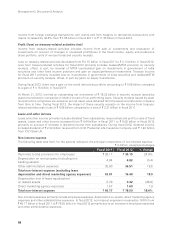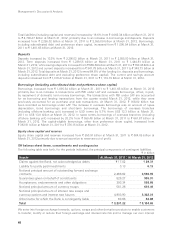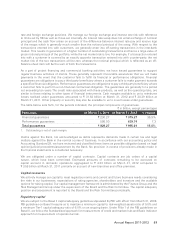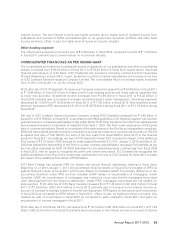ICICI Bank 2012 Annual Report Download - page 68
Download and view the complete annual report
Please find page 68 of the 2012 ICICI Bank annual report below. You can navigate through the pages in the report by either clicking on the pages listed below, or by using the keyword search tool below to find specific information within the annual report.
66
Classification of loans
We classify our assets as performing and non-performing in accordance with RBI guidelines. Under these
guidelines, an asset is classified as non-performing if any amount of interest or principal remains overdue
for more than 90 days, in respect of term loans. In respect of overdraft or cash credit, an asset is classified
as non-performing if the account remains out of order for a period of 90 days and in respect of bills, if the
account remains overdue for more than 90 days. In compliance with regulations governing the presentation
of financial information by banks, we report non-performing assets net of cumulative write-offs in our financial
statements.
RBI has separate guidelines for restructured loans. A fully secured standard asset can be restructured by
re-schedulement of principal repayments and/or the interest element, but must be separately disclosed as
a restructured asset. The diminution in the fair value of the loan, if any, measured in present value terms,
is either written off or a provision is made to the extent of the diminution involved. Similar guidelines apply
to sub-standard loans. The sub-standard or doubtful accounts which have been subject to restructuring,
whether in respect of principal installment or interest amount are eligible to be upgraded to the standard
category only after the specified period, i.e., a period of one year after the date when first payment of interest
or of principal, whichever is earlier, falls due, subject to satisfactory performance during the period.
The following table sets forth, at March 31, 2011 and March 31, 2012, information regarding the classification
of our gross customer assets (net of write-offs, interest suspense and derivatives income reversal).
` in billion
March 31, 2011 March 31, 2012
Standard assets ` 2,608.30 ` 3,048.57
Of which: Restructured assets 20.64 47.09
Non-performing assets 101.14 95.63
Of which: Sub-standard assets 17.92 14.49
Doubtful assets 74.00 73.35
Loss assets 9.22 7.79
Total customer assets1` 2,709.44 ` 3,144.20
1. Customer assets include advances, lease receivables and credit substitutes like debentures and bonds but
exclude preference shares.
2. Restructured assets are upgraded to standard category on satisfactory payment performance for a minimum
period of 12 months as per restructuring terms.
The following table sets forth, at the dates indicated, information regarding our non-performing assets (NPAs).
` in billion, except percentages
Year ended Gross NPA1Net NPA Net customer
assets
% of net NPA to net
customer assets2
March 31, 2010 ` 96.27 ` 39.01 ` 2,091.22 1.87%
March 31, 2011 ` 101.14 ` 24.58 ` 2,628.16 0.94%
March 31, 2012 ` 95.63 ` 18.94 ` 3,059.84 0.62%
1. Net of write-offs, interest suspense and derivatives income reversal.
2. Customer assets include advances and credit substitutes like debentures and bonds but exclude preference
shares.
At March 31, 2012, the gross NPAs (net of write-offs, interest suspense and derivatives income reversal) were
` 95.63 billion compared to ` 101.14 billion at March 31, 2011. Net NPAs were ` 18.94 billion at March 31,
2012 compared to ` 24.58 billion at March 31, 2011. The ratio of net NPAs to net customer assets decreased
from 0.94% at March 31, 2011 to 0.62% at March 31, 2012. During fiscal 2012, we wrote-off NPAs, including
retail NPAs, with an aggregate outstanding of ` 11.83 billion against ` 2.29 billion during fiscal 2011.
Management’s Discussion & Analysis
























